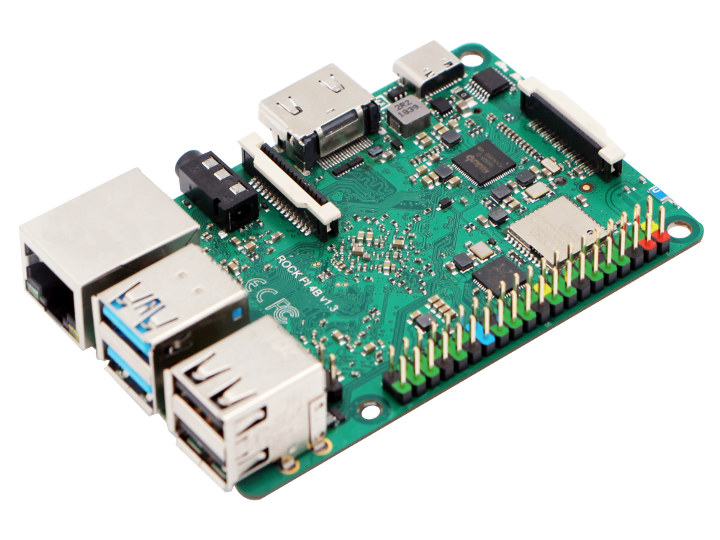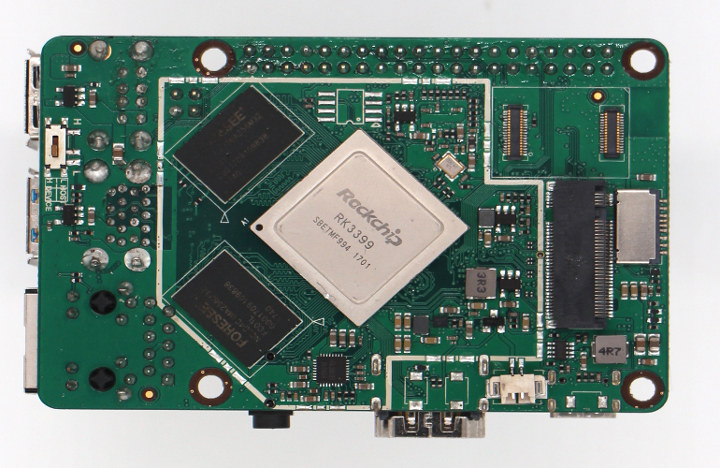The long awaited RPi 4 is almost finally here! Except we’re not talking about Raspberry Pi 4, but Rock Pi 4 designed by Radxa team, back after three years following the launch of Radxa Rock 2 Square, with the new SBC just unveiled by Tom Cubie, Radxa founder.
Rock Pi 4 single board computer is powered by a Rockchip RK3399 hexa-core processor coupled with 1 to 4GB RAM, and following Raspberry Pi 3 and ASUS Tinker board form factor.

There will be two variants with Rock Pi 4 Model A and Model B sharing most of the same specifications:
- SoC – Rockchip RK3399 big.LITTLE hexa-core processor with 2x Arm Cortex-A72 @ up to 1.8 GHz, 4x Cortex-A53 @ up to 1.4 GHz, a Mali-T864 GPU with support OpenGL ES1.1/2.0/3.0/3.1, OpenVG1.1, OpenCL, DX11, and AFBC, and a VPU with 4K VP9 and 4K 10-bit H265/H264 decoding
- System Memory – 1, 2 or 4GB LPDDR4 @ 3200 Mbps
- Storage – eMMC module socket, micro SD card slot up to 128GB, M.2 NVME SSD socket
- Video Output / Display Interface
- HDMI 2.0a up to 4K @ 60 Hz
- 2-lane MIPI DSI via FPC connector
- Dual independent display support
- Audio – Via HDMI and 3.5mm audio jack; HD codec supporting up to 24-bit/96Khz audio
- Camera – MIPI-CSI2 connector for camera up to 8MP
- Connectivity
- Rock Pi 4A – Gigabit Ethernet
- Rock Pi 4B – Gigabit Ethernet with PoE support (additional HAT required), 802.11ac WiFi 5, Bluetooth 5.0 with on-board antenna
- USB – 1x USB 3.0 host port, 1x USB 3.0 OTG port, 2x USB 2.0 host ports
- Expansion – 40-pin expansion header with 1x UART, 2x SPI bus, 2x I2C bus, 1x PCM/I2S, 1x SPDIF, 1x PWM, 1x ADC, 6x GPIO, and power signals (5V, 3.3V and GND)
- Misc – RTC
- Power Supply – Via USB-C port supporting USB PD 2.0 (9V/2A, 12V/2A, 15V/2A, or 20V/2A) and Qualcomm Quick Charge 3.0/.0 (9V/2A, 12V/1.5A). It’s also possible to power the board via a 5V/3.4A power adapter, but it is not recommended
- Dimensions – 85 x 54 mm
So the only real difference between model A and model B is the latter includes a wireless module, and optional support for PoE.
 The main advantage of relying on Raspberry Pi form factor is that you can use/re-use Rasperry Pi add-ons, including official ones, and for example, the official Raspberry Pi 7″ display and the Raspberry Pi Camera V2 IMX219 have all been tested successfully on Rock Pi boards. Just to be clear compatible here means hardware compatible, but not software compatible, as Raspberry Pi 3 images won’t magically work on Rock Pi 4. Initial / WiP documentation is available on Radxa wiki, as well as a dedicated website.
The main advantage of relying on Raspberry Pi form factor is that you can use/re-use Rasperry Pi add-ons, including official ones, and for example, the official Raspberry Pi 7″ display and the Raspberry Pi Camera V2 IMX219 have all been tested successfully on Rock Pi boards. Just to be clear compatible here means hardware compatible, but not software compatible, as Raspberry Pi 3 images won’t magically work on Rock Pi 4. Initial / WiP documentation is available on Radxa wiki, as well as a dedicated website.
Tom Cubie did not inform me about pricing, and there’s no such info on the website that I could find, but LinuxGizmos reports the Rock Pi Model A will sell for $39 (1GB), $49 (2GB) and $65 (4GB), while the Model B will go for $49 (1GB), $59 (2GB) or $75 (4GB).

Jean-Luc started CNX Software in 2010 as a part-time endeavor, before quitting his job as a software engineering manager, and starting to write daily news, and reviews full time later in 2011.
Support CNX Software! Donate via cryptocurrencies, become a Patron on Patreon, or purchase goods on Amazon or Aliexpress




